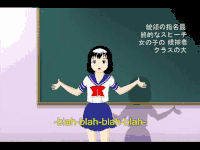Limited animation
Limited animation is a process in the overall technique of traditional animation of creating animated cartoons that does not redraw entire frames but variably reuses common parts between frames.
Early history

The use of budget-cutting and time-saving animation measures in animation dates back to the earliest commercial animation, including cycled animations, mirror-image and symmetrical drawings, still characters, and other labor-saving methods. In general, the progression was from early productions in which every frame was drawn by hand, independent of each other drawing, toward more limited animation that made use of the same drawings in different ways.
Winsor McCay, a man who put an unprecedented amount of detail into his animations, boasted that in his 1914 film, Gertie the Dinosaur, that everything moved, including the rocks and blades of grass in the background. In contrast, his 1918 film The Sinking of the Lusitania progressed to using cels over still backgrounds, while still maintaining a level of detail comparable to that of Gertie.[1]
The 1942 Merrie Melodies short The Dover Boys is one of the earliest Warner Bros. cartoons to extensively employ some of the processes of what would become known as "limited animation," particularly its use of characters that either stand still or move so quickly that the actual motion appears to be a blur.[2]
American television
Hanna-Barbera Productions used limited animation throughout its existence. When the company's namesakes, William Hanna and Joseph Barbera, separated from the MGM studio in 1957, they opted to take a drastically different approach to animation than they had for their fully animated film shorts; as television screens were much smaller than theater screens at the time, limited animation, with its emphasis on character close-ups and dialogue-based humor, was a better fit for the more intimate home viewer experience.[3]
The financial benefits of limited animation led to television animation companies relying on the process extensively in the television era. Jay Ward Productions relied on limited animation for those reasons,[4] compensating with its heavy Cold War satire and a style of deadpan comedy that would become a trademark of the studio's style.[5] One of the frequent users of limited animation was HB's Saturday-morning rival Filmation (makers of He-Man and the Masters of the Universe and BraveStarr) which gave their work a distinct look.[6] Bill Meléndez used a form of limited animation to adapt the Peanuts franchise to television and later film; in addition to the cost and time concerns (especially for his first special A Charlie Brown Christmas, which was given only a $76,000 budget and four months to produce 30 minutes of animation), Meléndez also noted that Peanuts creator Charles M. Schulz had designed the characters with a flat style well-suited for limited animation.[7] The short-lived Cambria Studios turned out three serials using one of the most inexpensive approaches to animation possible: known as Syncro-Vox, it involved superimposing film of the voice actor's moving lips over a still frame of the character.[8]
By the 1970s, the usage of limited animation in Saturday morning cartoons had become an epidemic; Walter Williams, creator of The Mr. Bill Show, noted that cartoons in the 1970s were so static, he expected the artist's hands to enter the screen at any moment and physically start moving the drawings around. This inspired him to create the "Mr. Hands" character in The Mr. Bill Show, who literally did just that.[9]
Japanese television
Limited animation proved to be particularly popular in Japan, such that the Japanese word for animation, anime, entered the English lexicon as a loanword for the distinctive, low-frame rate style of limited animation that took root there.[10] Anime features scenes of mouth moving with occasional eye blinks, rendered long shots of detailed backgrounds and rare use of 2D fluidity on motion-blur filled action alongside reused drawings. It also has the benefit of lower cost productions and stylized content as opposed to realistic animation.[11][12] As was the case in the United States, television was a major impetus for the growth of anime in Japan; the country's recovery from World War II led to economic prosperity and a boom in Japanese television ownership, and the development of anime allowed Japan to compete in an animation field where they had previously lagged well behind the West.[10]
See also
- Cutout animation
- Flash animation
- Motion comic
- PowerPoint animation
- Squigglevision
- Stock footage
- UPA (animation studio)
- Adult Swim
References
- Canemaker, John (2005). Winsor McCay: His Life and Art (Revised ed.). Abrams Books. ISBN 978-0-8109-5941-5.CS1 maint: ref=harv (link)
- Chuck Jones: Extremes and In-betweens - A Life in Animation (PBS 2000)
- Hanna, William; Ito, Tom (1996). A Cast of Friends. Taylor Pub. pp. 77–87. ISBN 978-1250040497.
- "Rocky & Bullwinkle". Cataroo.com. Retrieved 2012-09-28.
- "Alex Anderson interview". Hogan's Alley. 26 October 2010. Archived from the original on 26 October 2010.
- Filmation Associates Studio Directory|BCDB
- Mendelson, Lee (2013). A Charlie Brown Christmas: The Making of a Tradition. It Books. ISBN 978-0-06-227214-0.CS1 maint: ref=harv (link)
- "Don't believe your eyes! How 'Clutch Cargo' cuts corners as a television comic strip", TV Guide, December 24, 1960, pp. 28-29.
- Williams, Walter (1998-08-01). The Mr. Bill Show. Philadelphia: Running Pr. ISBN 9780894710858.
- Anime's Great Deception-The Difference Between Anime and Cartoons
- Is Anime a Legitimate Form of Animation?-Animator Island
- Animation Styles: What Make Anime Unique-Show Me The Animation.com